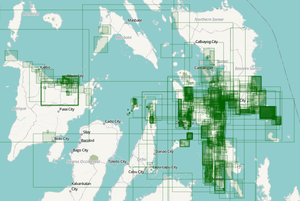User:Vgeorge/Pt:2017 Chapada dos Veadeiros Fires
Sobre o OpenStreetMap
OpenStreetMap é um mapa livre editado por contribuidores do mundo inteiro, atualizado minuto-a-minuto. Diversas ferramentas e serviços que utilizam dados do OpenStreetMap estão disponíveis, como, por exemplo: arquivos roteáveis para dispositivos GPS Garmin, navegação off-line em Android/iOS e download de dados brutos. É o mapa ideal para uso offline, podendo também serem impressos.
Consulte a área de mapeamento para ter uma noção do estado atual dos dados. Diferentes estilos de mapa podem ser selecionados no lado direito. Alguns dados podem não ser renderizados (aparecer no mapa), mas estarão lá na ocasião de uma exportação (veja a seção "Exportando dados do OpenStreetMap", mais adiante).
Instruções para organizações
Map and data services

About OpenStreetMap
OpenStreetMap offers an online map (and spatial database) which is updated by the minute. Various tools and services allow data extracts for GIS specialists, Routable Garmin GPS data, Smartphone GPS navigation, and other device-compatible downloads. With an internet connection, regular syncing is possible with open access to the community contributed data as it comes in, with OpenStreetMap's bulk data downloads ideal for use offline. In addition, maps can also be printed to paper.
Browse the activation area to get a feel for the data that is currently available. Different map styles including an Humanitarian style can be selected on the right side, and some data may not render (appear) on the map, but could be exported from the underlying database (See export section below).
Paper maps
Poster size maps and normal sized paper atlases of custom areas can be printed:
- FieldPapers ‒ paper maps with grid for field survey or general navigation purposes.
Exporting OpenStreetMap data
Anyone can use OSM data for free under the Open Database Licence (ODbL) as long as OSM contributors are credited. Exports of the OSM data for affected areas of earthquakes in Mexico can be downloaded from the OSM Export Tool, and the Humanitarian Data Exchange (HDX) platform (![]() @humdata
@humdata![]() ). Datasets are being published through the Export Tool as mapping projects are being completed on the Tasking Manager. Please check back frequently for new datasets listed in the table below.
). Datasets are being published through the Export Tool as mapping projects are being completed on the Tasking Manager. Please check back frequently for new datasets listed in the table below.
The exports listed in the table below contain formats for Garmin (.imp) and .mwm which works in the mobile app MAPS.ME.
For mappers
How you can contribute
Learn to map
- You can contribute to the response via the internet by tracing buildings, roads, waterways, etc. (as requested by project). Visit the Missing Maps beginners section to get started.
- For more information visit LearnOSM.org for modular training on a wide variety of OSM topics from beginner to advanced.
Mapping
- Please choose from highest priority first. Pre-disaster situations should be simple to complete fast, just validating the essential missing infrastructures. Post-disaster mapping could require much more work and more complex planning of emergencies, but will require newer specific imagery source.
- Generic instructions on how to use the Task Manager and map roads, buildings and waterways can be found here.
- For experienced mappers, information on validating the tasks can be found here.
Projects
To be included.
Available imagery
OSM default imagery sources
- Bing provides a global imagery data source that is the 'default' Imagery available for OSM (default option in most editors).
- Mapbox provides a global imagery source.
- DigitalGlobe provides two global imagery sets.
- ESRI World Imagery is also a global imagery source.
How to add/use alternative imagery
In many cases better imagery is available than the default; when possible we set up a remote link directly via the Tasking Manager, so there is nothing to do, the iD editor and (as long as enabled) JOSM will automatically add the imagery.
Additionally, with JOSM, it's relatively easy to add special imagery if the license is appropriate for tracing into OSM. For more details see JOSM Imagery Help
About this campaign
About the Brazilian community
To be described
History of this activation
No activities yet.
Coordination
This activation is being coordinated by:
Let us know if you want to help with coordination. You may also chat in the Brazilian community group in Telegram.
Press coverage
- Brazil's Chapada dos Veadeiros park ravaged by fire (2017-10-25)
- (Portuguese) Qual o tamanho do dano causado pelo incêndio na Chapada dos Veadeiros (2017-10-24)
Donate
Emergencies such as this put a tremendous strain on OSM resources, particularly our servers and software. Your donations help keep OSM's systems operating in top form.
